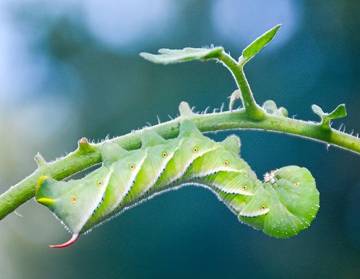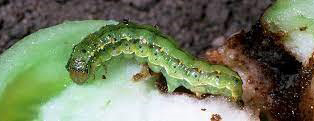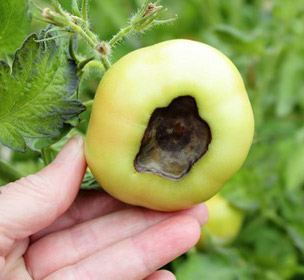Common Tomato Problems
Do you have tomato problems? We can help!
Searcy, Ark. –
Insects
 Tomato hornworms are large (2 to 3 inches long when fully grown) green worms with
white stripes on their bodies and a horn protruding from the top of the rear end.
They feed on the leaves and fruit and can quickly defoliate a plant.
Tomato hornworms are large (2 to 3 inches long when fully grown) green worms with
white stripes on their bodies and a horn protruding from the top of the rear end.
They feed on the leaves and fruit and can quickly defoliate a plant.
They are difficult to see when small. Pick the worms off or use a suggested biological insecticide, such as Dipel, Bt or Thuricide.
Tomato fruitworms (photo: UC IPM) are almost sure to be found in the garden. The moth lays the eggs in the terminal growth (top growth of the plant) then the larvae (small worms) hatch and make their way to the fruit. Once a larva is inside the fruit, it’s too late to save that fruit. Use the recommended insecticide every seven days.
 Stinkbugs attack the fruit and produce small, irregular, cloudy white spots under
the skin of the fruit.
Stinkbugs attack the fruit and produce small, irregular, cloudy white spots under
the skin of the fruit.
Diseases
Verticillium and fusarium wilt are diseases that cause yellowing of the leaves, wilting and premature death of the plant. These diseases persist in gardens where susceptible plants grow, and the only practical control is resistant (VF) varieties.
Early blight is characterized by dead brown spots that usually start on the lower leaves, spread up the plant and cause defoliation. Upon close inspection, concentric rings can be seen within the spots. Although early blight is most severe on the leaves, it sometimes occurs on the stems. Use fungicide sprays for high yields and quality fruit. Some varieties are more tolerant of early blight than others. Remove diseased leaves from the garden and dispose of them.
Septoria leafspot is characterized by numerous small brown spots on the leaves. The centers of these spots later turn white, and tiny black dots appear in the white center. The disease starts on the bottom leaves and may become severe in wet weather. Use suggested fungicides for control.
Physiological Disorders
 Blossom-end rot, a dry, leathery rot on the blossom end of the fruit, is common in
homegrown tomatoes. It is caused by a combination of calcium deficiency and wide fluctuations
in soil moisture.
Blossom-end rot, a dry, leathery rot on the blossom end of the fruit, is common in
homegrown tomatoes. It is caused by a combination of calcium deficiency and wide fluctuations
in soil moisture.
Severe pruning stresses the plants and increases the incidence of blossom-end rot. Some tomatoes are much more susceptible to this condition than others. Liming the soil, mulching and uniform watering help prevent blossom-end rot.
Read my article to learn more about preventing blossom-end rot
Poor fruit set of large-fruited tomatoes occurs when night temperatures remain warm, above 72 degrees F, for six hours or more. Cherry tomatoes will continue to set fruit during these warm periods.
For more info on poor fruit set, check out the Self-Sufficient U blog post top 3 reasons your tomatoes aren't producing.
Poor color and sunscald occur when high temperatures retard the development of full color in tomatoes exposed directly to the sun. Sunscald appears on the fruit during hot, dry weather as a large whitish area. It becomes a problem when foliage has been lost through other diseases, such as early blight. (Photo: Alabama CES)
For more information check out our tomato page. You can also use our tomato pathology tool to identify plant disease.
By Sherri Sanders
Extension Agent - Agriculture
U of A System Division of Agriculture
White County Cooperative Extension Service
2400 Old Searcy Landing Road Searcy AR 72143
(501) 268-5394
ssanders@uada.edu